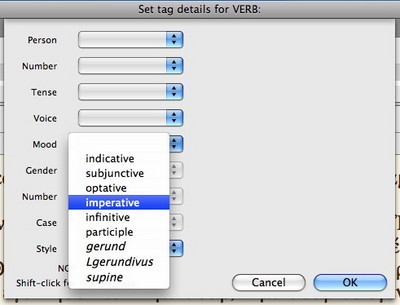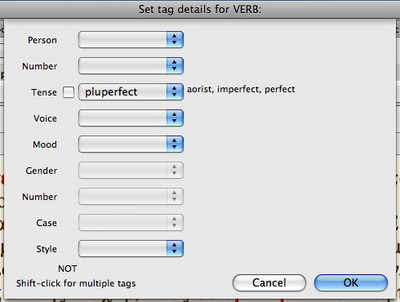As a writer, I’m something of a stickler for proper grammar, correct punctuation, and good sentence structure. However, I’m also of the opinion that the truly skillful writers know when to bend or even break the rules. A slavish adherence to rules many readers aren’t even aware of can actually hinder communication, and when that happens, no one will care that you avoided dangling prepositions (like the one I used in the previous clause). The goal of good writing is effective communication, even when it means bending a few grammatical rules.
The same thing is true of interface design. Good design means following the established interface guidelines the vast majority of the time. However, there are times when you may need to bend the rules a bit in order to make life easier for the user.
Throughout this week, I’ve been talking about how Accordance lets you search grammatically-tagged original language texts without forcing you to learn some cryptic set of codes and commands. In my previous post on this subject, I contrasted Accordance’s Set Tag details dialog box with other programs’ simplified interfaces for building grammatical searches. Where other programs accost you with an array of checkboxes for every conceivable grammatical characteristic, Accordance presents you with a clean, uncluttered column of pop-up menus.
Now, technically, checkboxes are the correct interface for choosing multiple items which are not mutually exclusive. For example, if you wanted to search for all past tense verbs in Greek, you could check the boxes for aorist, imperfect, perfect, and pluperfect. Then you could check other boxes for additional constraints. The disadvantage of the checkbox interface is that with so many different grammatical characteristics, finding the right checkbox is a bit like finding a needle in a haystack.
Pop-up menus, on the other hand, are designed to let you choose just one of a number of options. By placing all the Greek tenses in a single pop-up menu, Accordance makes it easier to find a particular tense. But what if you want to select four tenses as in the example just given?
Before I tell you how we made that possible, let’s take a moment to consider what the user is likely to do most of the time. We believe that in most cases, you’ll want to select a single form rather than multiple forms. You’re more likely to search for aorist verbs than for aorists, imperfects, perfects, and pluperfects all at once. With that in mind, wouldn’t the interface which makes it easy to do what you’ll do most often be preferable? We thought so, which is why we chose pop-ups over checkboxes from the very beginning.
By making that choice, did we therefore prevent you from choosing multiple items within the same category? Not at all, because we weren’t afraid to bend the rules a little bit. If you want to select multiple items within the same category, you need only hold the shift key while selecting them. As you do, the one you last selected will appear in the pop-up menu, and all your previous selections will be collected to the right of the menu. The dialog box even instructs you to “Shift-click for multiple tags.” When you click OK, Accordance once again translates your choices into an easily understandable syntax: [VERB (pluperfect, aorist, imperfect, perfect)].
Normally multiple selections from a pop-up menu are not possible, because it’s not immediately apparent which items are selected. That’s why we display the other selections to the right of the pop-up. By bending the rules a little, we created an interface which makes simple selections simple, and which can easily be extended to accommodate far more sophisticated searches. That way, we avoid the visual clutter of fifty checkboxes without limiting your choices.
In my next post in this series, we’ll look at how easy Accordance makes it to negate particular forms—something which is surprisingly difficult to do in other programs.



